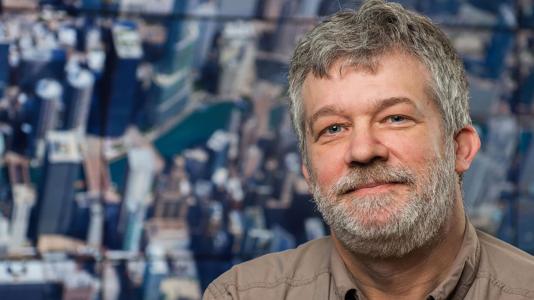
Charlie Catlett, a senior computer scientist in the Mathematics and Computer Science Division at Argonne National Laboratory, was the honored speaker at the 2019–2020 Distinguished Lecture Series at Academica Sinica, Taiwan, on September 12, 2019. His visit continues a number of longstanding collaborations between Argonne and academic partners in Taiwan. Catlett has been collaborating for several years with computer scientists and air quality sensor experts there, benefiting from the experience of teams in Taiwan who have built and deployed large-scale sensor networks, as well as image-processing capabilities, such as flood detection algorithms.
Catlett’s current research focuses on urban data analytics, urban modeling, and the design and use of sensing technologies. In his lecture, Catlett spoke on “Embedding Intelligence in Urban Infrastructure: Array of Things.”
“We hear a lot about “smart” cities today. But what exactly makes a city smart?” Catlett asked. He identified several necessary features: sustainability, resilience, health and well-being, economic and social opportunity, and vision strategy — with an emphasis on people and a recognition that technology and infrastructure are tools to support those features.
To make a city smart also requires data, and many sensor networks have been developed and deployed in our cities to collect such data. “Why, then, do we need a new approach?” Catlett asked. His answer: we need a new generation of measurement with intelligent devices that are programmable, along with new methods and tools to identify and understand interdependencies within the growing volume of data. With input from scientists, policymakers, and residents of Chicago and funding from the National Science Foundation, Argonne National Laboratory and the University of Chicago created the Array of Things (AoT) — a new form of intelligent urban measurement system implemented in partnership with the City of Chicago.
“AoT devices include embedded, remotely programmable, artificial intelligence capabilities — ‘edge computing’ — to process images, sound, vibration, and other data within the installed devices, creating measurements such as those related to pedestrian or vehicle flow, the impact of rail crossing on traffic flow, or characterizing the sources of noise. These types of measurements are not feasible using simple sensor networks. The project also involves hundreds of locations, providing these new measurements across the city while also including sensors for air quality and weather, with greater spatial and temporal resolution than is available from traditional sources of such data,” according to Catlett.
The AoT nodes can run machine learning software without having to feed data back to a central server. This means that state-of-the-art “software-defined” sensors can operate without collecting and storing images or sound, as these data types are deleted after they are analyzed within the devices. Besides saving on the cost of data transmission and storage, this approach allows for a very strong privacy policy.
“While Chicago is our main center of deployment, we have established AoT partnerships in a growing number of cities worldwide — including Taiwan. The transformational potential for society is enormous, enabling comparative studies across diverse cultures, climates, sizes, and densities,” Catlett said.
Slides and a video of Catlett’s presentation are available here.